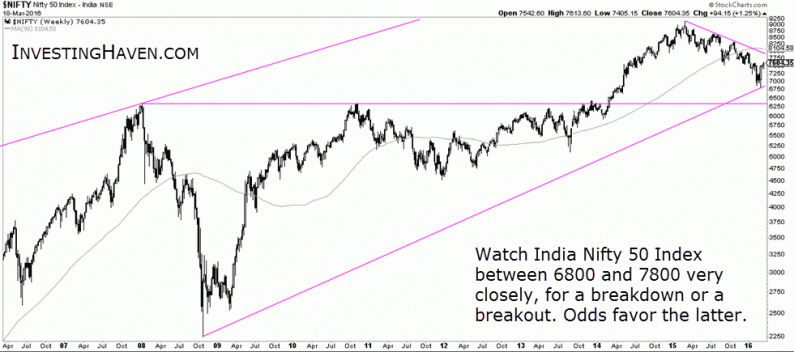We have said repeatedly that India is by far our favorite play in the world of emerging markets, among several articles it was also explained here.
Basically, there are two reasons which explain our above average interest for India. First, its economy is growing approximately 6% per year, according to data over 2015. Second, it has the most constructive chart pattern of all strongly growing emerging markets, as explained here.
Can we derive anything from India’s chart since we wrote our previous pieces? We definitely can. The first chart below highlights India’s secular trend lines in purple. From a secular perspective, India is in a long term uptrend, as proven by the parallel lines (trend channel). Within that channel, India is falling since mid-2014, but bounced very strongly at secular support in February of this year. So far, there was ‘no need’ to test the breakout levels of 2008 and 2010 (horizontal line).

The conclusion of this chart is that the price area between 6800 and 7800 points of the index is critical. We forecasted that 2016 will be the year in which India will break out big time, and we still hold on to that forecast. For investors who want to take a position, it is key to watch what happens in that range between 6800 and 7800, as those levels represent the breakdown and breakout points.
It always pays to look at an asset within its larger context. In the case of India, we should look at what other emerging markets are doing. Before getting too excited about India, we want to make sure that emerging markets as a group are in an uptrend. That would make India’s case even more compelling.
The emerging markets complex, represented by the ETF with symbol EEM, looks trendless at this point. Recently, EEM bounced off secular support, similar to India. There is certainly quite some upside potential until resistance is tested. But so far, there is no structural uptrend.

On the other hand, we see a very strong correlation between crude oil and emerging markets. As seen on the last chart, especially in the last 18 months, both assets were very strongly correlated, even more than the years before. That suggests that investors should also be closely monitoring the crude oil market. As a retest of the lows is certainly in the cards, it could provide a very interesting entry point in emerging markets, especially in India, provided that the previous lows hold.











Leave A Comment